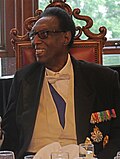| Mwami of Rwanda | |
|---|---|
 | |
 | |
| Details | |
| Style | His Majesty |
| First monarch | Gihanga I |
| Last monarch | Kigeli V Ndahindurwa |
| Formation | Unknown (ancient times) |
| Abolition | 28 January 1961 |
| Residence | Nyanza, Rwanda |
| Appointer | Royal Council of Abiru |
| Pretender | Prince Emmanuel Bushayija |
This article contains a list of kings of Rwanda. The Kingdom of Rwanda was ruled by sovereigns titled mwami (plural abami), and was one of the oldest and the most centralized kingdoms in the history of Central and East Africa.
Contents
- Kings of Rwanda
- Before 14th century
- 14th–20th centuries
- Timeline (1700–1961)
- Pretenders since 1961
- See also
- References
Its state and affairs before King Gihanga I are largely unconfirmed and highly shrouded in mythical tales.





